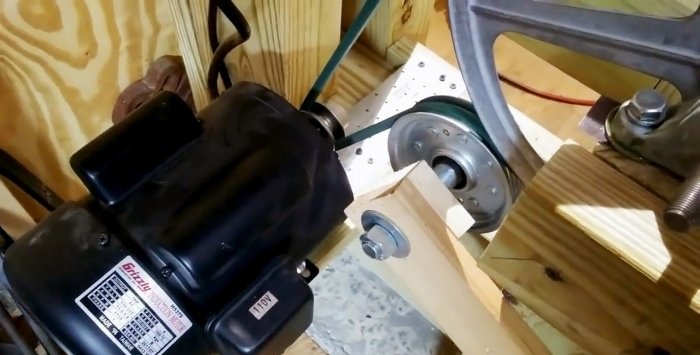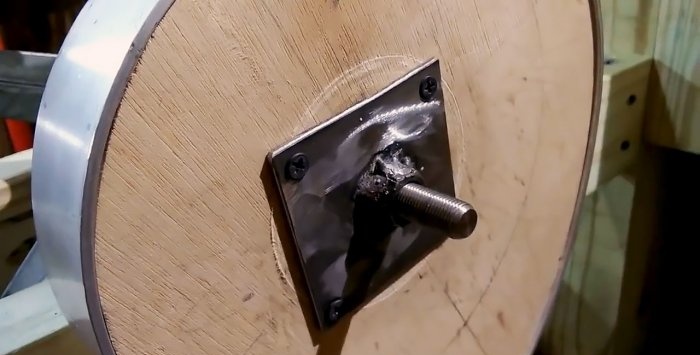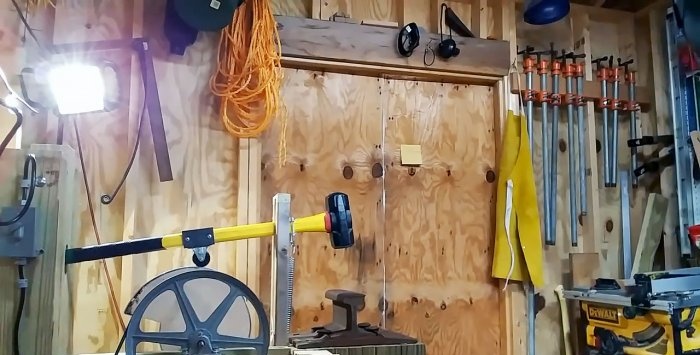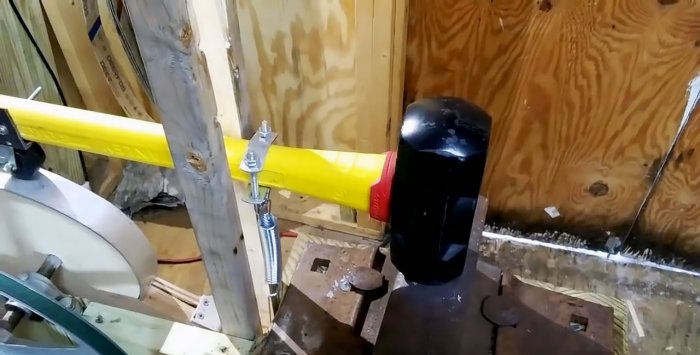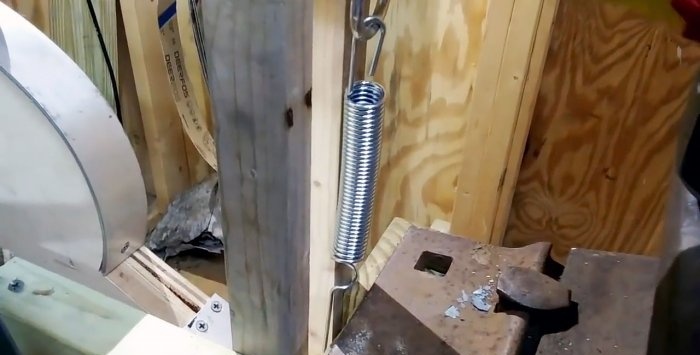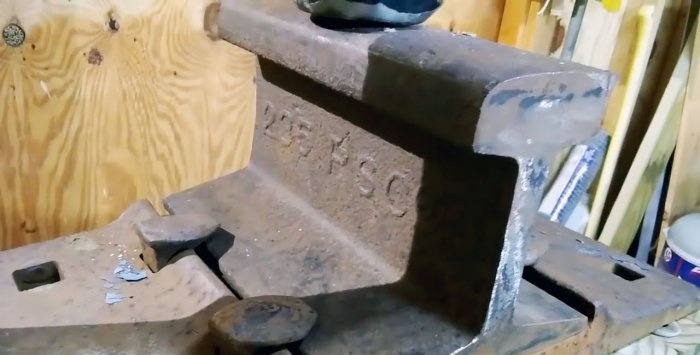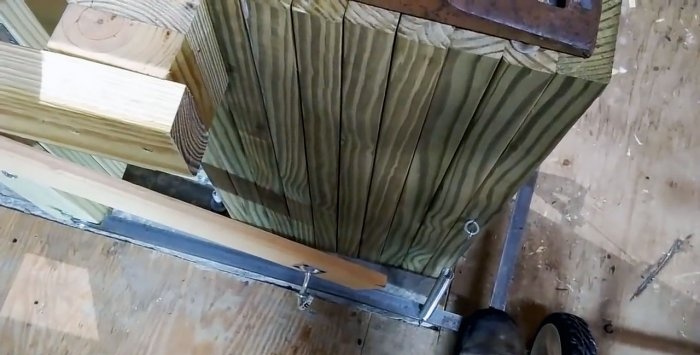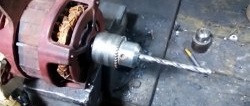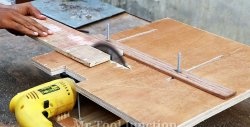Mechanical drive for sledgehammer
When doing blacksmithing, the big difficulty is the initial rough forging of the workpiece. This work can be greatly facilitated by a homemade mechanical drive by striking the anvil with a hammer. He hits with a heavy sledgehammer with high frequency and always with the same force, which allows him to unforge the part in one heating process much more than by hand.
The base of the machine is a wooden workbench assembled from timber and boards. It consists of three supports for securing the mechanism parts. They are connected at the bottom by a common base and are connected at the top by a pair of bars.
An electric motor with a small pulley on the shaft is mounted on the side shelf of the first support of the workbench.
It is wearing a drive belt, stretched over a large pulley fixed on the central support.It is mounted on a long axle, held by two housing bearings on the legs.
The large driven pulley is much larger than the drive pulley, which reduces the gear ratio from the electric motor but provides power.
A homemade eccentric made from 2 spliced sheets of plywood is attached to the axis of the large pulley. It is covered with an aluminum strip to protect against wear.
The eccentric is tightly fixed to the shaft, so it rotates together with the large pulley.
At the top of the first support, the end of the sledgehammer handle is fixed using a bearing, which allows it to move in one plane. Next, a furniture wheel is installed on the handle, resting on the eccentric.
Above the beginning of the third support of the workbench, a rigid clamp with a spring is attached to the handle of the sledgehammer, pulling the hammer down.
A wooden frame is also provided to limit the upper stroke of the sledgehammer.
An anvil or rail is installed on the third support. Its height is selected so that the hammer, rested with a furniture wheel on the lowest point of the eccentric, reaches the anvil with a gap of a couple of millimeters.
A rail is attached to the top of the central support on one fastening so that its fastening is used as the axis of rotation of the entire arm. A tension roller or pulley is attached to the edge of the rack near the engine, the purpose of which is to tighten the sagging drive belt. The second end of the shoulder is connected using a lanyard to a square metal profile almost parallel to it, located below. Thanks to one fastener, it also works as a shoulder. Its axis of rotation is also located on the central support, but lower. The free end of the square is pulled up by a spring attached to the base of the anvil stand.
Using a lanyard, the distance between the rack and the square is adjusted so that when you press the square pipe to the floor with your foot, the tension of the drive belt on the motor is obtained.
To use the hammer you need to start the engine. After this, by pressing the steel square with your foot, you can tighten the belt, after which the sledgehammer, thrown by the eccentric and accelerated by the spring, will begin to hit the anvil. As soon as you release your foot, the belt will sag and the blows will stop.
Hammer at work:
Basic materials:
- electric motor with pulley;
- large pulley with axle;
- drive belt;
- tension pulley or roller with axle and bearings;
- sledgehammer;
- furniture wheel;
- anvil or spring;
- 2 tension springs;
- lanyard;
- slats and boards;
- aluminum strip 40 mm;
- plywood 20 mm;
- 2 housing bearings on the feet for the axis of the large pulley;
- square pipe 20x20 mm.
Making a mechanical sledgehammer
The base of the machine is a wooden workbench assembled from timber and boards. It consists of three supports for securing the mechanism parts. They are connected at the bottom by a common base and are connected at the top by a pair of bars.
An electric motor with a small pulley on the shaft is mounted on the side shelf of the first support of the workbench.
It is wearing a drive belt, stretched over a large pulley fixed on the central support.It is mounted on a long axle, held by two housing bearings on the legs.
The large driven pulley is much larger than the drive pulley, which reduces the gear ratio from the electric motor but provides power.
A homemade eccentric made from 2 spliced sheets of plywood is attached to the axis of the large pulley. It is covered with an aluminum strip to protect against wear.
The eccentric is tightly fixed to the shaft, so it rotates together with the large pulley.
At the top of the first support, the end of the sledgehammer handle is fixed using a bearing, which allows it to move in one plane. Next, a furniture wheel is installed on the handle, resting on the eccentric.
Above the beginning of the third support of the workbench, a rigid clamp with a spring is attached to the handle of the sledgehammer, pulling the hammer down.
A wooden frame is also provided to limit the upper stroke of the sledgehammer.
An anvil or rail is installed on the third support. Its height is selected so that the hammer, rested with a furniture wheel on the lowest point of the eccentric, reaches the anvil with a gap of a couple of millimeters.
A rail is attached to the top of the central support on one fastening so that its fastening is used as the axis of rotation of the entire arm. A tension roller or pulley is attached to the edge of the rack near the engine, the purpose of which is to tighten the sagging drive belt. The second end of the shoulder is connected using a lanyard to a square metal profile almost parallel to it, located below. Thanks to one fastener, it also works as a shoulder. Its axis of rotation is also located on the central support, but lower. The free end of the square is pulled up by a spring attached to the base of the anvil stand.
Using a lanyard, the distance between the rack and the square is adjusted so that when you press the square pipe to the floor with your foot, the tension of the drive belt on the motor is obtained.
To use the hammer you need to start the engine. After this, by pressing the steel square with your foot, you can tighten the belt, after which the sledgehammer, thrown by the eccentric and accelerated by the spring, will begin to hit the anvil. As soon as you release your foot, the belt will sag and the blows will stop.
Watch the video
Hammer at work:
Similar master classes
Particularly interesting
Comments (0)


